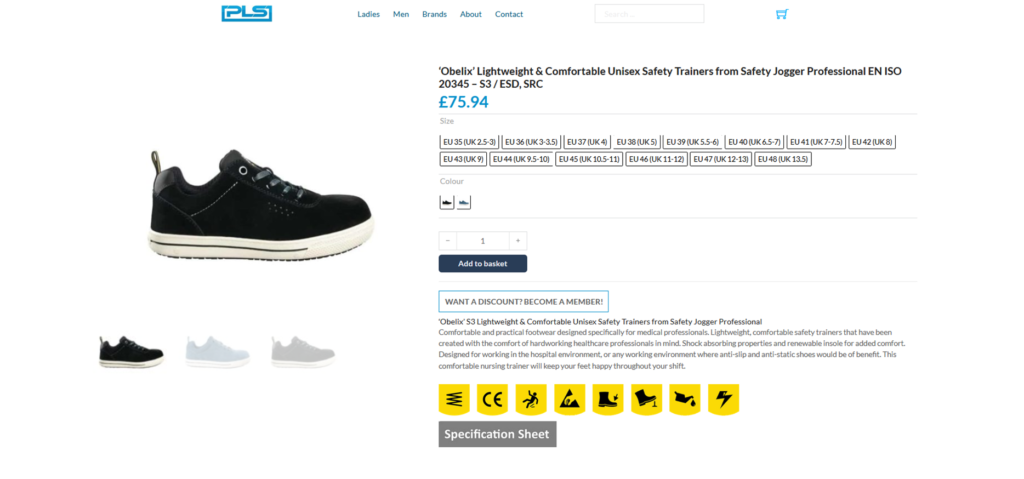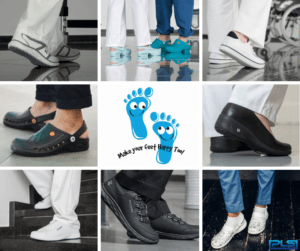Safety & Occupational Footwear Explained
Legislation
According to the Health and Safety Law, which governs the PPE regulation 2016, employers are responsible for ensuring their employees are properly equipped for their jobs. In essence, this means that PPE should be used whenever a risk is present at work. For identifying the required level of protection, a risk assessment may be necessary.
Standard
Work and safety footwear can be classified into three main categories, each with its own ISO code;
- ISO 20347:2012 – PPE: Occupational Footwear – describes basic and additional requirements for general purpose protective footwear.
- ISO 20345:2011 – PPE: Safety Footwear – describes basic and additional requirements for general purpose safety footwear.
- ISO 20346:2014 – PPE: Protective Footwear – defines basic and additional requirements for general-purpose protective footwear.
The ISO 20347:2012 standard for occupational footwear does not require a safety toecap. The only difference between safety footwear and protective footwear classifications is the requirement for the level of impact resistance in joules. Both classifications require a safety toecap.
The occupational footwear classification level would be appropriate in an environment where the risks are slipping without any mechanical or impact risks, such as a hospital operating theatre. Safety or protective levels would be appropriate in environments with high mechanical risks, such as construction or manufacturing.
Besides the specification included with each classification, complementary job-related standards cover special risks, such as footwear for firefighters, electrical insulating footwear, and footwear protecting against chainsaw injuries, chemicals and molten metal splash. Therefore, anyone issuing footwear must ensure that it meets at least one of the above standards, as well as that it is appropriate for the environment.
The following table provides further details on each standard, as well as the ISO definitions:
| Standard: | Covering: | Official ISO Definition: |
| ISO 20347:2012 | Personal Protective Equipment – Occupational Footwear | Provides basic and additional (optional) requirements for occupational footwear that is not subject to mechanical hazards (impact or compression). NB: Special risks are addressed by complementary job-related standards (e.g. footwear for firefighters, electrical insulating footwear, chain saw injuries, chemicals, molten metal splashes, motorcycle riders). |
| ISO 20345:2011 | Personal Protective Equipment – Safety Footwear | Outlines the basic requirements for safety footwear used for general purposes, as well as additional requirements (optional). There are many types of risks, such as mechanical risks, slip resistance, thermal risks, ergonomic risks, etc. Complementary job-related standards address special risks (e.g. footwear for firefighters, electrical insulating footwear, chain saw safety, protection against chemical splashes, motorcycle safety). |
| ISO 20346:2014 | Personal Protective Equipment – Protective Footwear | Provides basic and additional (optional) requirements for general-purpose protective footwear. Among them are mechanical risks, slip resistance, thermal risks, and ergonomics. Complementary job-related standards address special risks (e.g. footwear for firefighters, electrical insulating footwear, chain saw safety, protection against chemical splashes, motorcycle safety). |
Footwear is split into two classes:
Class 1 refers to footwear constructed from leather and other materials, but not rubber and polymers, while Class 2 refers to footwear made from rubber and polymers, including moulded shoes and boots.
The classifications within each of these footwear standards range from ‘B’ for basic, 1, 2 or 3 for class 1, and B, 4 or 5 for class 2 this is illustrated in the table below.
Regular reviews are conducted on these standards.
| Requirements footwear Class 1(leather or other materials except rubber & polymers) | ISO 20345:2011Safety Footwear | ISO 20346:2011Protective Footwear | ISO 20347:2012Occupational Footwear |
| Basic requirements for shoes and impact resistance of toecaps | SB200 Joule | PB100 Joule | OBNo requirement |
| Additional requirements:· Closed heel· Antistatic· Energy absorption around the heel | S1 | P1 | O1+ fuel resistant sole |
| Additional requirements, as above plus:· Water penetration· Water absorption | S2 | P2 | O2 |
| Additional requirements, as above plus:· Penetration resistance· Cleated sole | S3 | P3 | O3 |
| Requirements footwear Class 2(manufactured in one-piece e.g. rubber & polymers) | ISO 20345:2011Safety Footwear | ISO 20346:2011Protective Footwear | ISO 20347:2012Occupational Footwear |
| Basic requirements for shoes and impact resistance of toecaps | SB200 Joule | PB100 Joule | OBNo requirement |
| Additional requirements:· Antistatic· Energy absorption around the heel | S4 | P4 | O4 |
| Additional requirements, as above plus:· Penetration resistance· Cleated outsole | S5 | P5 | O5 |
You may have noticed other letters accompanying the classifications above such as ‘HRO’. These codes relate to additional safety properties such as outsole resistance to hot contact (HRO). These abbreviations are detailed in the table below:
| Additional requirements for special applications | |
| Abbreviation: | Risk covered: |
| P | Penetration resistance |
| C | Conductive |
| A | Antistatic |
| I | Electrically Insulating |
| E | Energy-absorbing seat region |
| HI | Insulating against heat |
| CI | Insulating against cold |
| WRU | Water-resistant upper only |
| CR | Cut resistant upper |
| HRO | Outsole resistant to hot contact |
| WR | Whole footwear resistant to water penetration/absorption |
| M | Metatarsal protection |
| AN | Ankle protection |
| FO | Fuel oil resistant outsole |
| ESD | Electrostatic |
| SRA | *Slip resistance tested on ceramic surface with “soap” |
| SRB | *Slip resistance tested on steel with glycerol |
| SRC | *Slip resistance tested on both of the above |
*Click here for further information on slip-resistance ratings
Many of the above requirements and their abbreviations are also represented by symbols, such as those you can see on the product pages.

When choosing safety footwear, the above information is very helpful. As an example, if you compare an S1P safety boot to an S3, the differences would be as follows:
The S1P offers the following protection:
- 200 joule toecap protection
- closed heel
- antistatic
- energy absorption around the heel
- penetration resistance (P)
And the S3 offers:
- 200 joule toecap protection
- closed heel
- antistatic
- energy absorption around the heel
- water penetration
- water absorption
- penetration resistance
- cleated sole
The HSE website provides additional information on specialist protection such as foundry work, chainsaw protection, and firefighting requirements.
As occupational, protective and safety footwear must meet or exceed the above standards there are product specification (data sheets) available for each product, which you can view or download from the product pages. To help you choose the best product, you can compare the product data.
If you would like further information on safety footwear or any particular product, please contact [email protected]
Would you like to learn more about professional footwear before making a decision? Here are some blog articles you may find helpful:
What are Anti-static and ESD? Click here to read our ‘Antistatic and ESD Explained’ blog.
What are slip-resistance standards? Click here to read our ‘Slips, Trips and Falls – Slip Resistance Explained’ blog.
Looking for student placement shoes? Click here to read our ‘Best Shoes for Student Nursing Placement’ blog.
Do you have Plantar Fasciitis or other common aches and pains? Click here to read our ‘The Best Shoes for Plantar Fasciitis’ blog.
Looking for washable footwear? Click here to read our ‘Washable Shoes and Clogs for Nurses’ blog.
Do you have sore or tired feet? Click here to read our ‘5 Top Tips for Happy Healthy Feet’ blog.
What are the best nursing shoes for you? Click here to read our ‘The Best Nursing Shoes’ blog.



